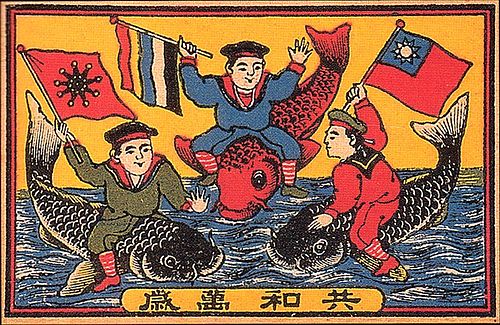Top Qs
Timeline
Chat
Perspective
Five Races Under One Union
Political principle of the Republic of China From Wikipedia, the free encyclopedia
Remove ads
Five Races Under One Union[a] was one of the major principles upon which the Republic of China was founded following the 1911 Revolution.[5][6][7][8] Its central tenet was the harmonious existence under one nation of what were considered the five major ethnic groups in China: the Han, the Manchu, the Mongols, the Hui (Muslims), and the Tibetans.[9]
Remove ads
Description
This principle emphasized harmony between what were considered the five major ethnic groups in China, as represented by the colored stripes of the Five-Colored Flag of the Republic: the Han (red); the Manchus (yellow); the Mongols (blue); the Hui or Muslims (white); and the Tibetans (black).[10]
The term "Hui" (回) here refers to all Muslims (回民, a.k.a. 穆斯林) in China as a whole regardless of ethnicity,[11] including Chinese-speaking Muslims, Turkic-speaking Uyghurs, Kazakhs, Uzbeks, Kyrgyzs and Tatars, Mongolic-speaking Dongxiangs and Bonans, and Iranic-speaking Pamiris, etc. The term "Muslim Territory" (回疆; Huíjiāng) was an older name for Xinjiang during the Qing dynasty.[12] It was only after the establishment of the People's Republic of China that the term "Hui" started to refer specifically to Chinese-speaking Muslims.[13][14]
Remove ads
History
Summarize
Perspective
Records from the Sui dynasty show a system of military banners using the five colors to represent the Five Elements: red for fire, yellow for earth, blue for wood, white for metal, and black for water. The Tang dynasty inherited this system, and has arranged the colors in a united flag according to the above order of the elements, for military use. During the Liao and Song periods, paintings depict the Khitan people using the same flag design. During the reign of the Mongol Yuan dynasty the five colors began to symbolize ethnicities (五色四夷) in a multi-ethnic state. In later historical periods, this "flag of the five united elements" was altered and re-adapted for military and official uses. A Qing-era painting depicting the victory of the Banners over the Muslim Du Wenxiu rebellion in Yunnan, includes a Qing military flag with the five elements arranged in the order of yellow, white, black, green and red.[citation needed]

After the Wuchang uprising, the Qing dynasty was replaced by the Republic of China. On 1 January 1912, during the Republic of China presidential inauguration, Sun Yat-sen mentioned the idea "Five Race Under One Union." He claims that the people are the core of a nation, and that uniting Han, Manchus, Mongols, Hui, and Tibetans as a country is to unite them all as one people.
Prior to the adoption of the five-colored flag by the Republic, several different flags were promoted by the revolutionaries. For example, the military units of Wuchang wanted a 9-star flag featuring a taijitu, while Sun Yat-sen preferred the Blue Sky and White Sun flag to honor Lu Haodong.[10]

Despite the uprisings targeting a Manchu-dominated regime, Sun Yat-sen, Song Jiaoren and Huang Xing unanimously advocated racial integration, which was symbolized by the five-color flag.[15] They promoted a view of the non-Han ethnicities as also being Chinese, despite their being a relatively small percentage of the population.[16] However, while Sun Yat-sen advocated for racial integration, he believes that the five-color flag, despite claiming the five race as equal, arranges the color from top to bottom, suggesting hierarchy.
The "five ethnic groups under one union" flag was no longer used after the Northern Expedition ended in 1928.
A variation of this flag was adopted by Yuan Shikai's empire and the Japanese puppet state of Manchukuo. In Manchukuo, a similar slogan was used, but the five races it represented were the Yamato (red), Han (blue), Mongols (white), Koreans (black) and Manchus (yellow). Some of its own variations also made the yellow more prominent, rather than display each color equally.
During the Second Sino-Japanese War, the flag was used by several Japanese puppet governments, including the Provisional Government of the Republic of China in the northern part of the country and the Reformed Government of the Republic of China in Central China.
Remove ads
Gallery
China
- National flag, 1912–1928 (used again by the Provisional Government 1937–1940, Reformed Government 1938–1940)
- Beiyang Army insignia, 1912–1928
- National flag of the Empire of China, 1915–1916
- Air force roundel, 1920–1921
- Commander-in-chief flag of the Republic of China (Beiyang Government), 1927–1928
- Reformed Government Army insignia, 1938–1940
- One of the proposed national flags of the People's Republic of China, August 1949
Manchukuo
- Manchuria Aviation Company roundel, 1931–1945
- National flag of Manchukuo, 1932–1945
- War ensign of Manchukuo, 1932–1945
- Manchukuo Army insignia, 1932–1945
- Manchukuo Air Force roundel, 1937–1945
Inner Mongolia ("four races")
- Mongol Military Government banner, 1936–1939
- South Chahar Autonomous Government banner, 1937–1939
- North Shanxi Autonomous Government banner, 1937–1939
- Flag of Mengjiang, 1939–1945
See also
Notes
References
Sources
Wikiwand - on
Seamless Wikipedia browsing. On steroids.
Remove ads


















